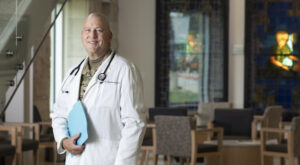
Story by Sgt. Tyler Brock
U.S. Army V Corps
FORT KNOX, Ky. — As the Army Medical Corps celebrates its birthday on July 27, Col. Francis Boudreau, corps surgeon assigned to V Corps, reflects on his journey, the unique challenges faced by V Corps, and the significant advancements in military medicine that continue to shape the Corps’ mission. The Medical Corps, which has been integral to the Army since its establishment in 1775, continues to evolve and meet the demands of modern warfare.
Before joining the Army, Boudreau volunteered for four years with the Peace Corps in Africa during the mid-1980s. His path to the Army and the Medical Corps was profoundly influenced by the events of Sept. 11, 2001.
“9/11 was a significant event that changed the perception of my work in the private sector as a civilian physician,” Boudreau said. “Witnessing the impact on the reservists and their families early on, who were repeatedly called up from 2001 to 2006, shook me to action.”
As the V Corps surgeon, Boudreau finds immense satisfaction in the reactivation of V Corps in Europe and the challenges that come with it.
“The re-establishment of V Corps in Europe and the challenges of establishing the area of operation in Eastern Europe is an open book,” he said. “Having the opportunity to assess the needs and find solutions is rewarding.”
His previous roles and studies in security cooperation at the Command and General Staff College prepared him for this position, where he anticipated the needs of V Corps and was drawn to its integration with NATO.
“V Corps is like 2nd Infantry Division/Korea on steroids,” Boudreau said. “The creation of V Corps with the NATO integration was intriguing.”
V Corps is the only forward-deployed corps, presenting unique challenges in maintaining a combat-ready medical force.
“Establishing and maintaining a combat-ready medical force is a tremendous challenge given the size of the area of operation and the constraints experienced throughout the Army at present,” he said.
Reflecting on the history of the Medical Corps, Boudreau highlights the challenges faced by the first medics in V Corps during World War I.
“Rapid and effective evacuation of the wounded in an era of litters, horses, wagons, and rail transportation… survival generally depended upon how quickly wounds were effectively treated, and many died during the evacuation process,” he said. “Without antibiotics, immediate surgical intervention was paramount, and the development of new weapon systems such as machine guns, gas, and shells resulted in a scale of injuries never before encountered. Additionally, infectious diseases, lice, and filth complicated the treatment process.”
Today, the Medical Corps has made significant advancements, such as Tactical Combat Casualty Care (TCC) training, which prepares combat medics embedded within the smallest tactical units to efficiently and effectively clear the battlefield and provide point-of-care treatment. These advancements are fundamental to providing the best chance of survival as soldiers move through evacuation echelons to receive higher levels of care.
“I have so much respect for 68W,” Boudreau emphasized, highlighting the vital role of combat medics who operate at the unit level, such as platoons, and provide critical care to their soldiers.
A crucial part of medical readiness on the battlefield is finding the quickest way to transport patients to an adequate facility. Boudreau stresses that rapid and efficient medical evacuation is essential for saving lives and ensuring soldiers receive timely and appropriate care.
Studying the complexities of medical care in the Russian war on Ukraine has influenced how Boudreau prepares medical planning efforts, pivoting from the counterinsurgency (COIN) construct to a large-scale combat operations (LSCO) environment.
“Analyzing and following the medical conditions and injuries taking place in Ukraine is an eye-opening experience,” he said. “For 20-plus years the medical community was tweaking our MEDEVAC and echelons of care in the COIN environment. We were revisioning IT solutions for medical employment. Now, studying the complexities of medical care in the Russian war on Ukraine is fundamentally influencing how I am preparing our medical planning efforts and pivoting from the COIN construct to a LSCO environment.”
Collaboration with the private sector plays a crucial role in introducing innovative solutions and technologies in military medicine.
“From new IT systems to new diagnostic technologies the field of medicine is evolving at a tremendous rate,” Boudreau said. “Many of these technological advancements are taking place in the civil sector and applied to the operational environment while other advances are developed within the contested environment and brought into the commercial realm. For example, modern tourniquets’ evolution and employment over the past 20 years juxtaposed to the effective use of ambulances in WWI.”
Throughout his career, Boudreau has balanced the immediate needs of soldiers on the ground with the long-term goals of the Medical Corps. He shares memorable experiences that have significantly impacted him and the soldiers he serves.
“I, as do many other physicians, have many anecdotal stories of care on and off the battlefield,” he reflected. “It never ceases to amaze me how varied the injuries are that soldiers can receive in garrison or in combat. I still picture those I have saved and those I have watched die while I held their hand. Additionally, I acutely remember the civilian casualties with life-threatening injuries that I have treated, reminding me of the serious ramifications of war and its impact on communities.”
As V Corps continues to navigate the complexities of modern warfare, Boudreau’s leadership and dedication to medical excellence ensure that soldiers receive the highest level of care, both on and off the battlefield. His work not only honors the legacy of the Army Medical Corps but also paves the way for future advancements that will enhance the readiness and effectiveness of V Corps in fulfilling its mission.